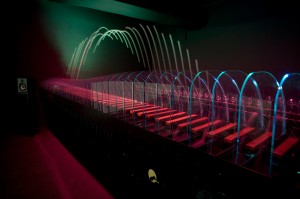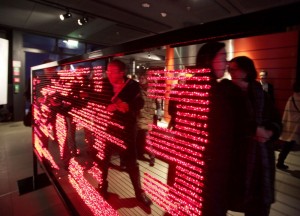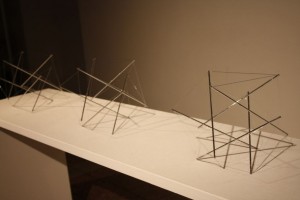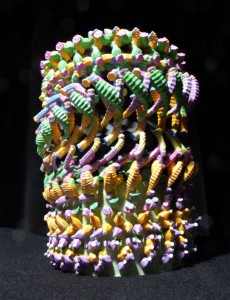Quartet 2008
Jeff Lieberman, Dan Paluska

Source: The artists
Award of Distinction in the Interactive Art category at Prix Ars Electronica 2008.
Become part of a musical quartet, by entering a short melodic theme, which is then performed as a unique three-minute piece of music by the three robotic members of the “Quartet”: The first is a ballistic marimba, which launches rubber balls 2m in the air, precisely aimed at marimba keys. 35 tuned wineglasses are played by robotic fingers, and an ethnic percussion ensemble round out the quartet. Your performance is broadcast live, and a video is archived on the homepage http://quartet.cc to share your creation with others.
According to Lieberman and Paluska, the most important quality of interactive art is its capacity to interconnect an incredibly diverse array of people and to foster collaboration. Accordingly, the pieces produced are “open source”, and anyone is free to use them.
Credits: Jeff Lieberman, Dan Paluska, Absolut V+S
 Poesie der Bewegung |
Poesie der Bewegung |  Permalink
Permalink
L–E–D–LED–L–ED 2008
dilight inc.

Source: rubra
Give free rein to your creativity with hundreds of tiny bead-shaped light-emitting diodes. Each LED draws its energy from the magnetic field of the wire its strung on. The beads can be moved back and forth along an array of parallel wires, so you can arrange them into any glowing pattern you want.
Credit: dilight inc.
 Poesie der Bewegung |
Poesie der Bewegung |  Permalink
Permalink
Structured Creature 2008
Yosuke Ushigome

Source: the artist
“Structured creature” is a prototype for an architectural element of the future. It interacts with its surroundings and the inhabitants of those surroundings. Its organic movement is generated by a “tensegrity” structure, in which fixed elements and ties form equilibrium between tension and compression (like roofs over a stadium). Additionally artificial muscles are used: a “shape memory” alloy “remembers” its shape and, after being deformed, can be returned to that shape when heat is applied to the alloy.
Credits:
Yosuke Ushigome, Kunihiro Nishimura, Yasuhiro Suzuki and Michitaka Hirose. This artwork is partly supported by JST CREST “Technology to Create Digital Public Art” project.
 Poesie der Bewegung |
Poesie der Bewegung |  Permalink
Permalink
Bellows 2008
Eric Dyer

Source: the artist
“Bellows” translates the principle of the zoetrope into the 21st century. 200 years ago, viewers peered through slits cut into the walls of a rotating cylinder at a sequence of static images on its interior wall; the cylinder’s rotation seemed to animate the images. Now, Dyer has replaced the images with hand-painted 3D computer prints, and the human eye with a camera. Here, though, the speed at which the objects fly by exceeds the eye’s ability to see. It is not until the camera images are transferred onto a screen that it becomes possible to register them.
 Poesie der Bewegung |
Poesie der Bewegung |  Permalink
Permalink
Arthur Ganson
Arthur Ganson has been developing kinetic sculptures for more than 25 years. Fascinated by manual work as well as by computer programming, he has developed works since his college days that combine both interests: accurate manual working and the examination of logical flows of energy within a closed system.
He is particularly fascinated by the question of how motion functions. For Ganson, his sculptures constitute a language all their own. They are not solely mechanical devices; rather, each relates its own story. Characteristic of his way of working is the combination of artificial and natural elements. Thus, in addition to wires and cogwheels, he also uses eggshells, feathers and chicken bones.
See all projects by Arthur Ganson
 Poesie der Bewegung |
Poesie der Bewegung |  Permalink
Permalink






